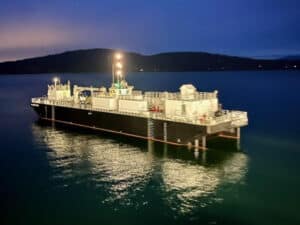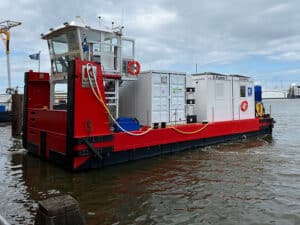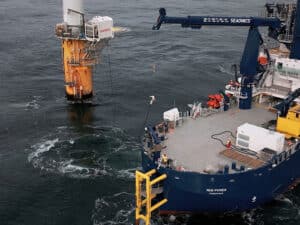
Liebherr says load hook failure caused collapse of giant offshore crane
Written by Nick Blenkey
YouTube video captured crane collapse
Crane manufacturer Liebherr says the collapse of a massive offshore crane during testing May 2, was the failure of a crane hook designed and manufactured by an external supplier. As we reported earlier, video of the collapse went viral on YouTube.
The 90 meter high crane with a 160 meter long boom is being installed on board the offshore installation vessel Orion 1 under construction for DEME by Chinese shipbuilder COSCO (Qidong) Offshore Co., which is, at this stage of construction, still the owner of the vessel.
The vessel arrived at Liebherr’s Rostock, Germany, facility on November 22, 2019, for assembly and installation of the giant 90 meter high Liebherr TLC crane.
Liebherr issued the following statement on the incident:
Accident During Overload Test
During an overload test of the offshore crane HLC 295000 from Liebherr-MCCtec Rostock GmbH a serious accident occurred resulting in two injured persons having to be taken to hospital for treatment. A further ten persons were treated by paramedics on site.
“At this point we wish the injured persons all the best and hope for a full and speedy recovery,” said Leopold Berthold, Managing Director of Liebherr-MCCtec Rostock GmbH. “Considering the extent of the damages, we are above all thankful that it did not cause more personal injuries. Our priorities currently lie in fully supporting the investigating authorities in order to contribute to the quickest possible clarification of the accident,” added Berthold.
At this stage in the investigations, the responsible authorities and experts unanimously agree that a broken crane hook was the cause of the accident. The exact reasons as to why the hook did not withstand the load are unclear at this stage of investigations. The design and manufacture of the crane hook was purchased from an external supplier. A design or production error of the Liebherr crane can therefore be excluded.
The overload test for the HLC 295000 was planned for a load scenario of 5,500 tonnes. The lift should have been carried out through the hoisting of a barge. Carrying out an overload test is a typical procedure for the industry, whereby the crane is tested for its maximum lifting capacity. Currently known facts indicate that the incident occurred at a load of around 2,600 tonnes causing a chain reaction which led to the accident.
As things stand, the accident has no effect on day-to-day operations at Liebherr-MCCtec Rostock GmbH. According to initial estimates, the damage amounts to a high double-digit million figure.




